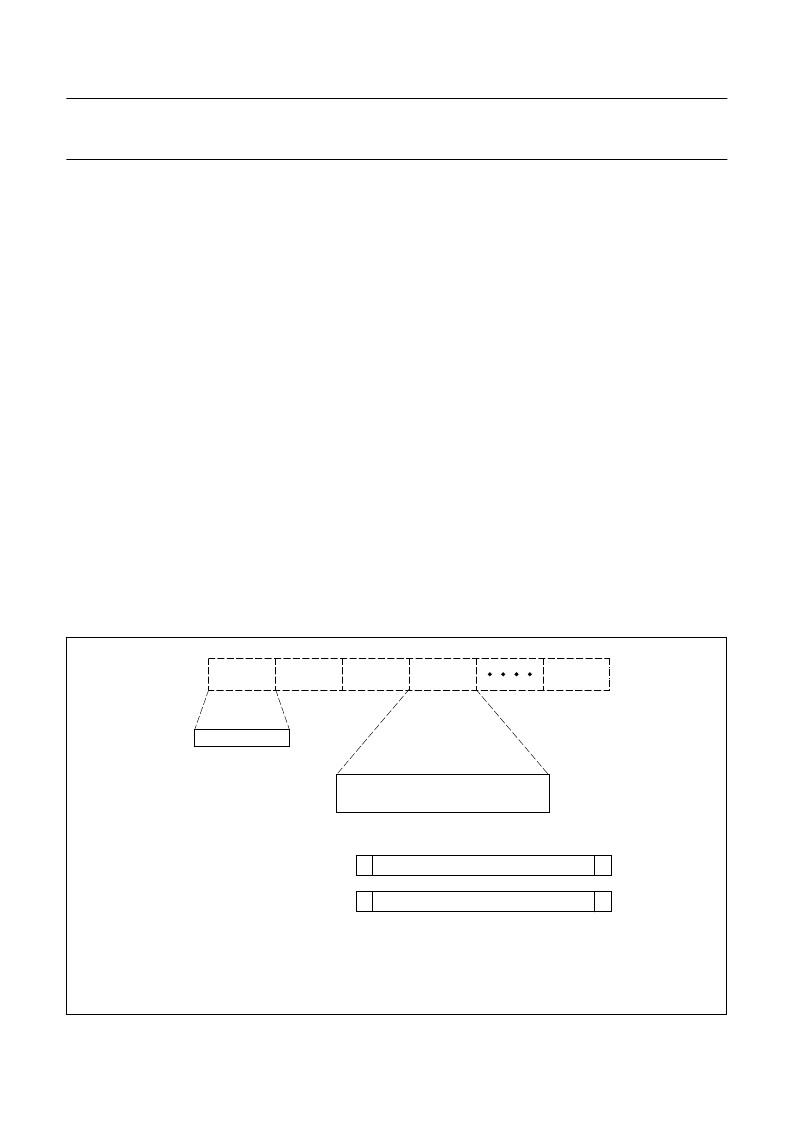- 您現(xiàn)在的位置:買賣IC網(wǎng) > PDF目錄367813 > PCD5002 (NXP Semiconductors N.V.) Advanced POCSAG and APOC-1 Paging Decoder PDF資料下載
參數(shù)資料
| 型號: | PCD5002 |
| 廠商: | NXP Semiconductors N.V. |
| 英文描述: | Advanced POCSAG and APOC-1 Paging Decoder |
| 中文描述: | 高級POCSAG碼和載脂蛋白C - 1尋呼解碼器 |
| 文件頁數(shù): | 7/48頁 |
| 文件大小: | 203K |
| 代理商: | PCD5002 |
第1頁第2頁第3頁第4頁第5頁第6頁當前第7頁第8頁第9頁第10頁第11頁第12頁第13頁第14頁第15頁第16頁第17頁第18頁第19頁第20頁第21頁第22頁第23頁第24頁第25頁第26頁第27頁第28頁第29頁第30頁第31頁第32頁第33頁第34頁第35頁第36頁第37頁第38頁第39頁第40頁第41頁第42頁第43頁第44頁第45頁第46頁第47頁第48頁

1997 Jun 24
7
Philips Semiconductors
Product specification
Advanced POCSAG and APOC-1 Paging
Decoder
PCD5002
Address codewords are identified by an MSB at logic 0
and are coded as shown in Fig.3. A user address or RIC
consists of 21 bits. Only the upper 18 bits are encoded in
the address codeword (bits 2 to 19). The lower 3 bits
designate the frame number (0 to 7) in which the address
is transmitted.
Four different call types (‘numeric’, ‘a(chǎn)lphanumeric’ and two
‘a(chǎn)lert only’ types) can be distinguished. The call type is
determined by two function bits in the address codeword
(bits 20 and 21), as shown in Table 1.
Alert-only calls consist only of a single address codeword.
Numeric and alphanumeric calls have message
codewords following the address. A message causes the
frame structure to be temporarily suspended. Message
codewords are sent until the message is completed, with
only the sync words being transmitted in their expected
positions.
Message
codewords are identified by an MSB at logic 1
and are coded as shown in Fig.3. The message
information is stored in a 20-bit field (bits 2 to 21).
The standard data format is determined by the call type: 4
bits per digit for numeric messages and 7 bits per (ASCII)
character for alphanumeric messages.
Each codeword is protected against transmission errors by
10 CRC check bits (bits 22 to 31) and an even-parity bit
(bit 32). This permits correction of a maximum of 2 random
errors or up to 3 errors in a burst of 4 bits (a 4-bit burst
error) per codeword.
8.3
The APOC-1 paging code
The APOC-1 paging code is fully POCSAG compatible
and involves the introduction of batch grouping and a
Batch Zero Identifier. This reserved address codeword
indicates the start of a ‘cycle’ of 5 or 15 batches long and
is transmitted immediately after a sync word.
Cycle transmission must be coherent i.e. a transmission
starting an integer number of cycle periods after the start
of the previous one.
Broadcast message data may be included in a
transmission. This information may occupy any number of
message codewords and immediately follows the batch
zero identifier of the first cycle after preamble.
The presence of data is indicated by the function bits in the
batch zero identifier: 1,1 indicates ‘no broadcast data’.
Any other combination indicates a broadcast message.
The PCD5002 can be configured for POCSAG or APOC-1
operation via SPF programming. The batch zero identifier
is programmable and can be stored in any identifier
location in EEPROM.
Fig.3 POCSAG code structure.
handbook, full pagewidth
PREAMBLE
BATCH 1
BATCH 2
BATCH 3
LAST BATCH
SYNC | CW CW | CW CW | . . . . . | CW CW
FRAME 0
FRAME 1
FRAME 7
10101 . . . 10101010
Address code-word
Message code-word
0
18-bit address
2 function bits
10 CRC bits
P
1
20-bit message
10 CRC bits
P
MCD456
相關(guān)PDF資料 |
PDF描述 |
|---|---|
| PCD5002H | Advanced POCSAG and APOC-1 Paging Decoder |
| PCD5 | Fuse |
| PCB1 | Fuse |
| PCB2 | Fuse |
| PCB2.5 | Fuse |
相關(guān)代理商/技術(shù)參數(shù) |
參數(shù)描述 |
|---|---|
| PCD5002A | 制造商:PHILIPS 制造商全稱:NXP Semiconductors 功能描述:Enhanced Pager Decoder for APOC1/POCSAG |
| PCD5002AH | 制造商:PHILIPS 制造商全稱:NXP Semiconductors 功能描述:Enhanced Pager Decoder for APOC1/POCSAG |
| PCD5002H | 制造商:PHILIPS 制造商全稱:NXP Semiconductors 功能描述:Advanced POCSAG and APOC-1 Paging Decoder |
| PCD5002HBD-S | 制造商:未知廠家 制造商全稱:未知廠家 功能描述:Telecommunication Decoder |
| PCD5002HBD-T | 制造商:未知廠家 制造商全稱:未知廠家 功能描述:Telecommunication Decoder |
發(fā)布緊急采購,3分鐘左右您將得到回復(fù)。